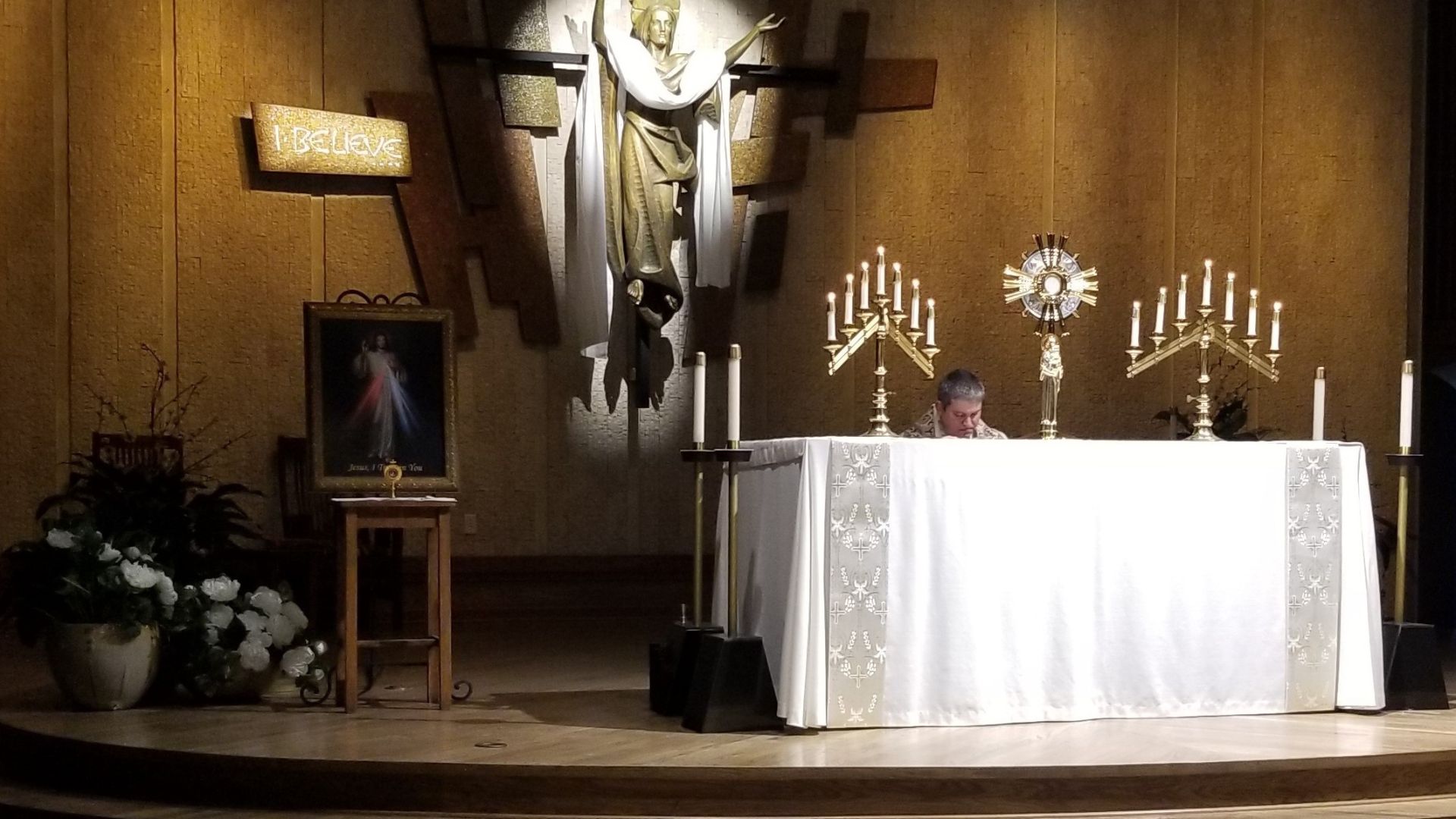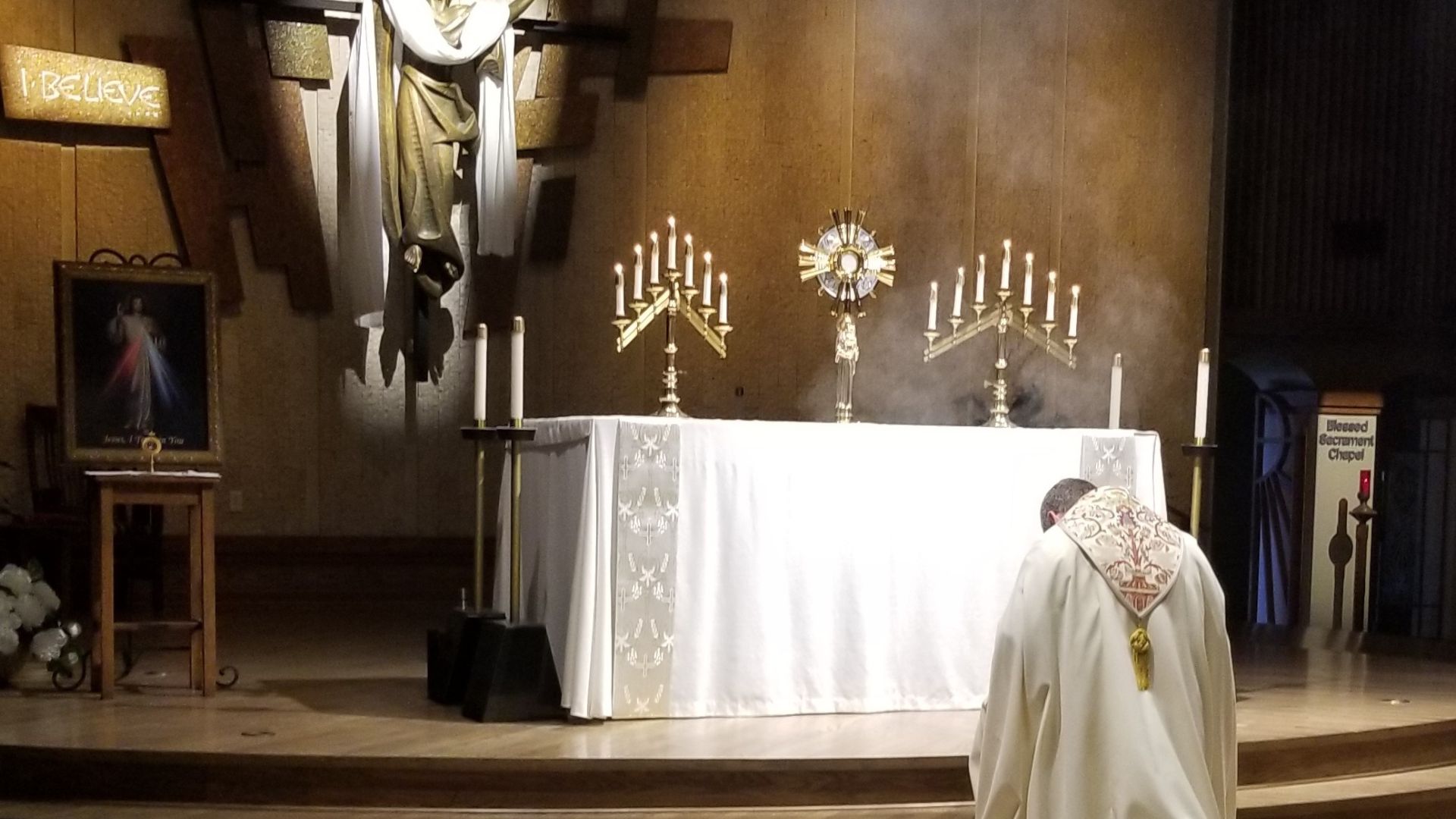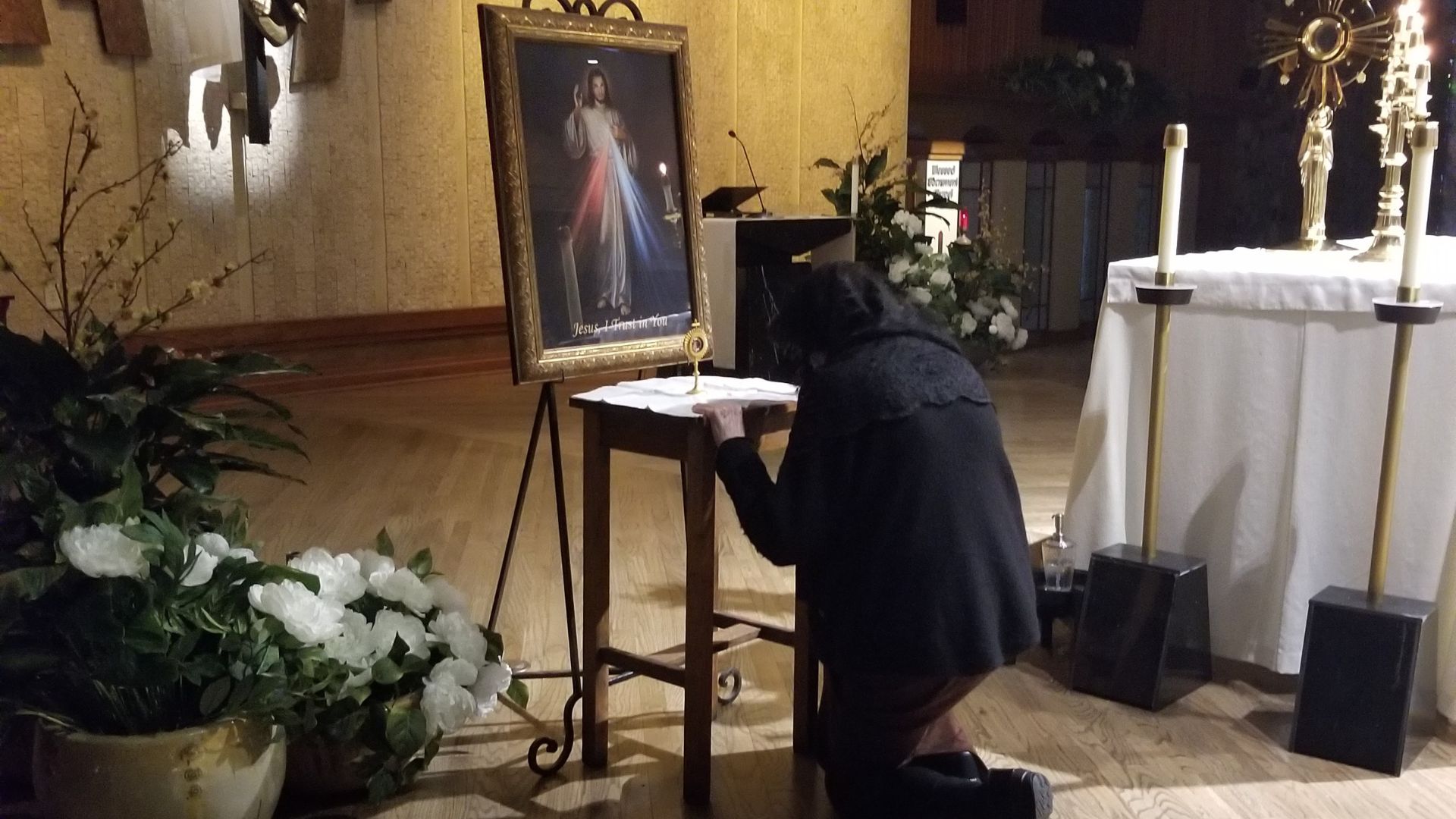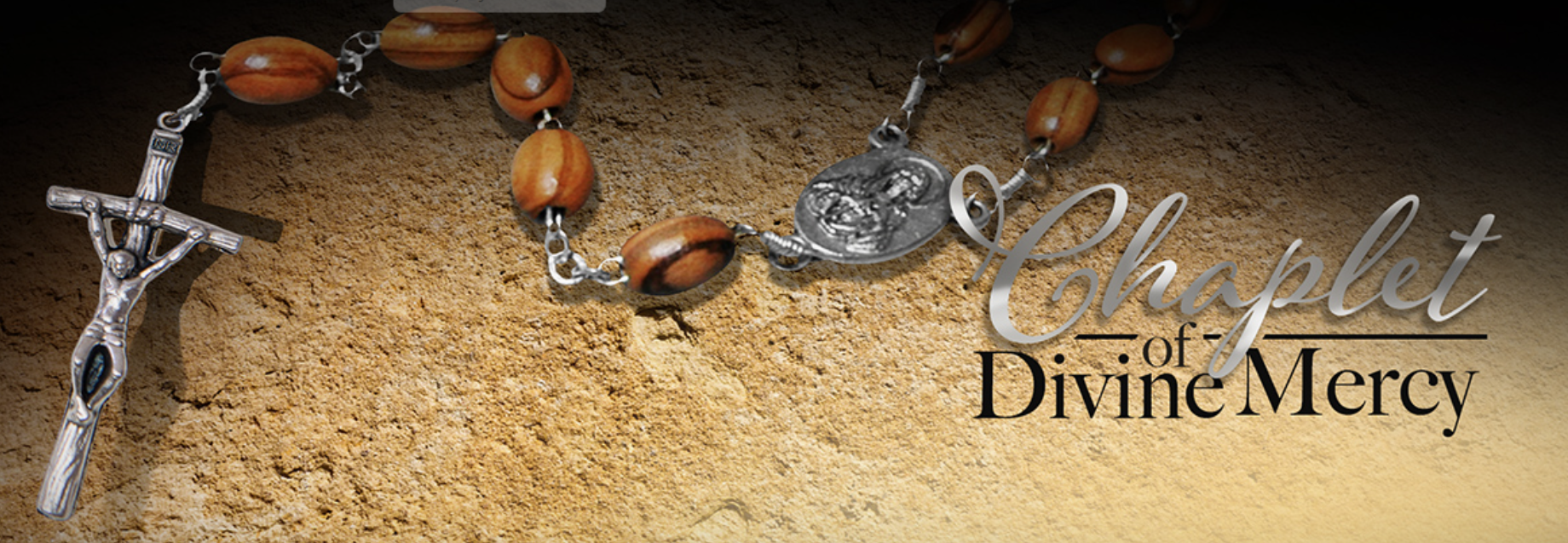“'Proclaim that mercy is the greatest attribute of God. All the works of My hands are crowned with mercy.'”
(No. 301)
Divine Mercy is celebrated on the Second Sunday of Easter, which concludes the Octave of Easter. The Octave of Easter is the eight-day period, or octave, that begins on Easter Sunday and ends with Second Sunday of Easter. It marks the beginning of Eastertide. The first seven of these eight days are also collectively known as Easter Week.
Extraordinary Graces on Divine Mercy Sunday
Adoration | Confession | Chaplet | Benediction
“I desire that the Feast of Mercy be a refuge and shelter for all souls, and especially for poor sinners. I pour out a whole ocean of graces upon those souls who approach the fount of My mercy (699).
“The graces of My mercy are drawn by means of one vessel only, and that is trust. The more a soul trusts, the more it will receive” (1578).
What Is Divine Mercy?
Divine Mercy has been called “the greatest grassroots movement in the history of the Catholic Church” and has changed millions of lives. But what is it?
The following is drawn from Fr. Michael Gaitley’s book Divine Mercy Explained:
Divine Mercy gets to the heart of Sacred Scripture. In fact, as the Catechism of the Catholic Church says, “The Gospel is the revelation in Jesus Christ of God’s mercy to sinners” (1849). Right there: That summarizes it. Divine Mercy is the Gospel. It’s the good news. And so, it gets to the very center of our faith. Moreover, in the words of Pope Benedict XVI, “Divine Mercy is not a secondary devotion, but an integral dimension of Christian faith and prayer.” Benedict even goes so far as to say, “[M]ercy is the central nucleus of the Gospel message.”
What is this thing that gets to the heart of Sacred Scripture and to the very center of our faith? To begin, mercy is “love’s second name,” as John Paul II said. It’s a particular kind of love, a particular mode of love when it encounters suffering, poverty, brokenness, and sin. Divine Mercy is when God’s love meets us and helps us in the midst of our suffering and sin. In fact, because this side of eternity we’re all sinners and because suffering is our lot in life, God’s love for us here always takes the form of mercy. It’s always the Lord stepping out in compassion to help us poor, weak, and broken sinners. From our perspective, then, every good we receive is an expression Divine Mercy.
The Message of Divine Mercy
The message of Divine Mercy is something that’s most associated with a Polish nun who died in 1938, about a year before the start of World War II. She’s known today as St. Maria Faustina Kowalska. Saint Faustina was a mystic. In other words, she received extraordinary experiences of the Lord Jesus in prayer. In fact, Jesus appeared to her and even spoke with her.
Jesus didn’t reveal some new Gospel when he appeared to St. Faustina. He already revealed everything He needed to say 2,000 years ago to the Apostles and through Sacred Scripture. So, why did He do it? Why did He appear to Faustina?
Actually, why does He appear to any mystic for that matter?
God sometimes appears to mystics because He has a prophetic message for a particular time in history, and He uses particular men and women to share His message. Sometimes it’s to remind us of something that’s been forgotten. Sometimes it’s a warning. At other times, it’s a message of comfort. Or it may simply be a call to conversion. Whatever it is, it doesn’t change the Bible. Rather, it brings us back to it at a certain time in history.
What is the particular and important message that God wants to give to us in our modern time through St. Faustina? Simple. He wants to remind us of the heart of Sacred Scripture, namely, His mercy for us sinners. In fact, He’s saying to us sinners, “Now is the time of mercy. Now is a time of extraordinary mercy! Now is a time when I want give especially great graces to the human race. I want to pour out My mercy in a big way.”
Why would God say this? Why would He want to give such great graces in our time? Blessed John Paul II explained it best. First, he pointed out something we all know: namely, that there are all kinds of blessings in our contemporary society. For instance, modern technology has done so much to make life easier for us. Just think of e-mail, cell phones, smartphones, and air-conditioning. All these things are blessings. Yet, in the midst of these blessings and in some ways because of the very same advances in technology that brought them, John Paul would say that evil has a reach and power in our day like never before. Indeed, our time, sadly, is marked by unprecedented evil. Despite this, John Paul would also say, “Be not afraid.” Why should we not be afraid? Because of what St. Paul writes in Romans, “Where sin increased, grace abounded all the more” (5:20). In other words, God is not outdone by evil. So, in a time of great evil, God wants to give even greater graces, and in our time, the graces are huge, precisely because there’s so much sin.
How can we tap into the extraordinary graces of our time? If there are tons of graces available to us, how are we to gather them in?
Tapping Into the Graces
FINCH | F - feast | I - image | N - novena | C - chaplet | H - hour
How do we get the great graces of Divine Mercy in our time? One important way to get them is to live out a devotion to Divine Mercy, and learning how to live it out is easy. All you need to know is one, little word – actually, it’s a little bird: finch. F-I-N-C-H. Finch. If you remember this word, you’ve got it.
F = Feast
“F” as in F…
What feast? The Feast of Divine Mercy, also known as Divine Mercy Sunday. Divine Mercy Sunday falls on the Second Sunday of Easter.
What’s so great about Divine Mercy Sunday? What’s the most important feast day of the year? Easter, right? And how many days is Easter?
We celebrate it for eight full days, which is why we call it the Octave of Easter. But the last day is the greatest of all. The eighth day. It’s the climax of the whole feast.
Well, Divine Mercy Sunday is the eighth day of Easter, the climax of the entire Easter celebration. In a sense, it’s the most important day of the most important feast!
Divine Mercy Sunday existed way before St. Faustina. In fact, it has its roots in the Easter celebrations of the early Church. When Jesus told Faustina that He wanted the feast celebrated, she asked some priests and theologians about it, and they told her, “There already is such a feast.” So, Faustina went back to Jesus and told Him, “They tell me that there already is such a feast, and so why should I talk about it?” Jesus responded, “And who knows anything about this feast? No one!” (Diary of St. Faustina, 341). In other words, the great feast of mercy had been forgotten and was almost completely unknown.
Imagine, Jesus saying to Faustina, “Look, I want people to know and celebrate this feast. And to sweeten the deal, I promise to give great graces on Divine Mercy Sunday.” Specifically, he told her:
On that day [Divine Mercy Sunday], the very depths of My tender mercy are opened.
I pour out a whole ocean of graces upon those souls who approach the fount of My mercy. …
On that day, all the divine floodgates through which graces flow are opened. (Diary of St. Faustina, 699)
Thousands upon thousands of people attest to the super-power of prayer offered on Divine Mercy Sunday. But we still haven’t gotten to our favorite part of Divine Mercy Sunday, what we call “the clean slate grace.”
Jesus told St. Faustina,”The soul that will go to Confession and receive Holy Communion shall obtain complete forgiveness of sins and punishment” (699). Now, that’s a big deal. It means that if we were to die right after receiving this grace, then we wouldn’t have to go to purgatory! In other words, our slate is wiped clean. In fact, the theologian who was assigned by the future Pope John Paul II to investigate the question “What is the grace of Mercy Sunday?” likened the grace to a second baptism. Of course, it’s not the same as Baptism, but it is an extraordinary grace of being cleansed of sin and the punishment due to sin.
Unfortunately, a lot of people confuse the great grace of Divine Mercy Sunday with a plenary indulgence. It’s not the same thing. To get a plenary indulgence, you need to do the indulgenced act, pray for the intentions of the Holy Father, go to confession (within 20 days), receive Holy Communion, and be detached from all sin.
Are we detached from all sin? Saint Philip Neri was speaking to a large crowd of people who had gathered for some Church event to receive a plenary indulgence, and the Holy Spirit told St. Philip that only two people in the whole crowd were going to receive the plenary indulgence: Philip himself and a seven-year-old boy – presumably because everyone else was attached to sin.
The good news about the grace of Divine Mercy Sunday is that to receive it, you simply need to go to confession before or on the feast – the experts say that sometime during Lent suffices – be in the state of grace (no mortal sin), and receive Holy Communion with the intention of obtaining the promised grace. We should also do acts of mercy such as forgiving people, praying for others, and having the intention to be more merciful to our neighbor.
I = Image
“I” as in F-I…
What image? The Image of Divine Mercy. Jesus told St. Faustina to have an image painted just as He looked when He appeared to her. She obeyed and had it painted by a Polish artist, Eugene Kazimirowski. It took him more than 12 tries before Faustina accepted it as satisfactory.
As you can see from the image, Jesus’ right hand is raised in blessing.
He’s taking a step toward us, and two rays of light issue from His Heart: a red ray and a pale ray , representing the blood and water that gushed forth from His pierced side on the Cross.
, representing the blood and water that gushed forth from His pierced side on the Cross.
At the bottom of the image, Jesus wanted a prayer to be written, “Jesus, I trust in You.” He also promised to give great graces through it. For instance, one time, He said:
“I am offering people a vessel with which they are to keep coming for graces …
that vessel is this image with the signature, Jesus, I trust in You.” By means of this image, I shall be granting many graces to souls. (327, 742)
We’ve received countless testimonies from people who have experienced special graces through the Divine Mercy image. One grace that comes through the image is this: It heals the way people often mistakenly view God. Here’s what we mean. People too often have a false image of God. They’re afraid of Him and see Him as some mean ogre just out to ruin their fun. Well, the Image of Divine Mercy helps to change that. In it, we discover our Merciful Savior who surely calls us to conversion but who also blesses us, loves us, and is deserving of all of our trust.
N = Novena
“N” as in F-I-N…
What novena? The Novena to Divine Mercy. A novena is basically nine days of prayer in a row. Jesus taught St. Faustina a novena that He wanted her to pray and that we can all pray. Each day He asked that a different group of people be entrusted to Him (for example, “all sinners” on day one and “all priests and religious” on day two). You can find the text for the entire Novena here.
Before moving to the next point, we’d just like to answer a question that people often ask about the novena: “When should I begin?” Well, it can be prayed at any time, but a special time to pray it is in preparation for Divine Mercy Sunday. The starting date for the novena, combined with praying the Chaplet of Divine Mercy (see below), is Good Friday, and it ends on the Saturday after Easter Sunday, the day before Divine Mercy Sunday. (Novenas typically end the day before the feast.) While you don’t have to pray this novena to obtain the grace of Divine Mercy Sunday, it is a good way to prepare, and Jesus promised, “By this novena, I will grant every possible grace to souls.”
C = Chaplet
“C” as in F-I-N-C…
What chaplet? The Chaplet of Divine Mercy. This is a prayer that’s prayed on ordinary rosary beads, and it’s pretty popular today – perhaps because it can be prayed in a short amount of time (about seven minutes). Divine Mercy Chaplet
I think another reason why the chaplet is so popular is because it’s such an incredibly powerful prayer. Why is it so powerful? Because it draws its strength from the holiest and mightiest prayer there is: the Mass. In other words, the Chaplet of Divine Mercy is a kind of extension of the prayer of the Mass. In fact, it’s a kind of extension of what we’ll call the “supercharged moment of the Mass.” Here’s what we mean: It’s an extension of that moment when the priest at the altar takes the Body and Blood of Christ into his hands and offers it up to the Father with these words:
Through Him, and with Him, and in Him, O God, almighty Father, in the unity
of the Holy Spirit, all glory and honor is Yours forever and ever. Amen.
That’s supercharged because, at the Mass, Jesus is giving Himself Body, Blood, Soul, and Divinity into our hands: literally, in the hands of the priest and spiritually, in the hands of all the lay faithful who are uniting their own sacrifices to the offering of the priest at the altar. Together, each in his own way, we offer Jesus’ infinite sacrifice of love to the Father. That’s the power of the Mass. It’s Jesus’ own sacrifice of love in our hands, held up to the Father, and the Father can’t resist such a perfect sacrifice of love. It really is the perfect prayer.
Now, the chaplet is an extension of that moment of the Mass, because on the “Our Father” beads of the rosary, we pray, “Eternal Father, I offer You the Body and Blood, Soul and Divinity of Your dearly beloved Son, our Lord Jesus Christ in atonement for our sins and those of [what? … my family? … my city? … no, not just that …] for the whole world.” So, it’s a bold prayer: It’s for the whole world! And it can be bold, because it relies on infinite merits: Christ’s infinite sacrifice of love on the Cross. Alright, so this explains the “Our Father” beads.
On each “Hail Mary” bead, we pray, “For the sake of His sorrowful Passion, have mercy on us and on the whole world.” In other words, as we’re holding up to the Father His Son’s infinite sacrifice of love, we keep repeating: “Mercy, mercy, mercy.” More specifically, we keep praying, “Have mercy on us and on the whole world.” And this is powerful. And you know who it’s most powerful for? The dying. Our Heavenly Father said to St. Faustina:
When this chaplet is said by the bedside of a dying person … unfathomable mercy envelops the soul, and the very depths of My tender mercy are moved for the sake of the sorrowful Passion of My Son. (811) Also, Jesus made several comforting promises to those who pray the chaplet: Say unceasingly the chaplet that I have taught you. Whoever will recite it will receive great mercy at the hour of death. … Even if there were a sinner most hardened, if he were to recite this chaplet only once, he would receive grace
from My infinite mercy. (687)
The souls that say this chaplet will be embraced by My mercy during their lifetime and especially at the hour of their death. (754) Oh, what great graces I will grant to souls who say this chaplet; the very depths
of My tender mercy are stirred for the sake of those who say the chaplet. (848) My daughter, encourage souls to say the chaplet which I have given to you. It pleases Me to grant everything they ask of Me by saying the chaplet. When
hardened sinners say it, I will fill their souls with peace, and the hour of their death will be a happy one. (1541)
H = Hour
“H,” as in F-I-N-C-H
What hour? The Hour of Great Mercy. Because Jesus died on the Cross for us at 3 p.m., every day between 3-4 in the afternoon is known as the Hour of Great Mercy. During this hour, Jesus asked St. Faustina to pray the Stations of the Cross, provided her duties permitted it. But He went on to say:
If you are not able to make the Stations of the Cross, then at least step into the chapel for a moment and adore, in the Blessed Sacrament, My Heart, which is full of mercy; and should you be unable to step into the chapel,
immerse yourself in prayer there where you happen to be … and if only for a brief moment, immerse yourself in My Passion, particularly in My abandonment at the moment of agony. (1572, 1320)
What Jesus wants above all, through this devotion, is that we have mercy on Him! In other words, He wants us to recall His sacrifice of love. He wants us to think about what He did for us on the Cross. He simply wants our love. So, let’s get “the three o’clock habit” and remember Jesus’ sacrifice of love for us, even if only for a moment.
Oh, and one other thing about the Three O’clock Hour: Jesus promised that it’s a huge time of grace: “This is the hour of great mercy for the whole world. … I will refuse nothing to the soul that makes a request of Me in virtue of My Passion” (1320). Thus, we can look at this hour as a kind of mini-Mercy Sunday that we have every day. So, it’s also a great time to pray for our loved ones, especially for the conversion of unrepentant sinners, and to recite the Chaplet of Divine Mercy.
The ABC’s
A = Ask for mercy | B = Be merciful in deed, word, and prayer | C = Completely Trust
The ABC’s
Father George Kosicki’s uses a teaching tool, the “ABC’s of Mercy,” to help.
A = Ask for mercy. In Sacred Scripture, Jesus tells us, “Ask and it will be given to you … for everyone who asks receives” (Mt 7:7, 8). In the Diary of St. Faustina, Jesus reminds us of this idea:
Souls that make an appeal to My mercy delight Me. To such souls I grant even more graces than they ask.
I cannot punish even the greatest sinner if he makes an appeal to My compassion (1146).
[B]eg for mercy for the whole world (570). No soul that has called upon My mercy has been disappointed (1541).
B = Be merciful in deed, word, and prayer. As we learned earlier, mercy is love’s second name. It’s a particular kind of love, a particular mode of love when it encounters suffering, poverty, brokenness, and sin. But it’s not just a movement of the heart. It’s not just feeling compassion for someone. To be true, mercy must also be put into action. So, mercy is really two movements: heart and arms. The “heart” part is the movement of compassion — it’s something we feel. The “arms” part is the movement to alleviate the suffering of another — it’s something we do. And what should we do? Jesus tells us in the Diary:
He is giving you three ways of exercising mercy toward your neighbor: the first — by deed, the second — by word, the third — by prayer.
In these three degrees is contained the fullness of mercy, and it is an unquestionable proof of love for Me.
By this means a soul glorifies Me and pays reverence to My mercy (742).
So, mercy in action is mercy in deed, word, and prayer. And whenever our hearts are moved to compassion, wherever we are, we can always put this compassion into action either by some deed that helps alleviate another person’s suffering, by some word that comforts or assists them, or by prayer.
As St. Faustina wrote: “If I cannot show mercy by deeds or words, I can always do so by prayer. My prayer reaches out even there where I cannot reach out physically” (163). Of course, one of the great prayers of mercy, as we learned earlier, is the Chaplet of Divine Mercy.
C = Completely Trust. Trust in the mercy of God gets to the heart of the message of Divine Mercy, which is why the Image of Divine Mercy has the prayer at the bottom, “Jesus, I trust in You.” Now, trust does not mean that we have license to go about sinning as we please. Rather, it implies that we repent of our sins. Anyway, here are some beautiful quotes from the Diary that have to do with trust:
Encourage the souls with whom you come in contact to trust in My infinite mercy.
Oh, how I love those souls who have complete confidence in Me — I will do everything for them. (294)
Why are you fearful and why do you tremble when you are united to Me? I am displeased when a soul yields to vain terror.
Who will dare to touch you when you are with Me? Most dear to Me is the soul that strongly believes in My goodness and has complete trust in Me. I heap My confidence upon it and give it all it asks. (453)
I desire that the whole world know My infinite mercy. I desire to grant unimaginable graces to those souls who trust in My mercy. (687)
I am Love and Mercy itself. When a soul approaches Me with trust, I fill it with such an abundance of graces that it cannot contain them within itself, but radiates them to other souls. (1074)
Sooner would heaven and earth turn into nothingness than would My mercy not embrace a trusting soul. (1777)
FINCH
Feast | Image | Novena | Chaplet | Hour
Please see videos below for more information
Special Graces
The worthy reception of the Eucharist on Divine Mercy Sunday is sufficient to obtain the extraordinary graces promised by Jesus. Also, a plenary indulgence[1] can be obtained by fulfilling the usual conditions. Nonetheless, there are many ways that you can enhance your liturgical celebrations.
A. Benediction
A brief Exposition and Benediction at the conclusion of the Eucharistic Liturgy would highlight the importance of the Eucharist and allow for a personal moment of worship and praise. Exposition invites us to contemplate the One whom we have received in sacramental Communion.
B. Veneration of The Divine Mercy Image
To “venerate” a sacred image simply means to perform some act or gesture of deep religious respect toward it because of who it represents. Here are some suggestions for parishes:
- Display the Divine Mercy Image in the sanctuary so that the parish may venerate it during the Eucharistic Liturgy.
- After the Communion Prayer, the priest may incense the Image and, kneeling before it, recite an appropriate prayer.
- Venerate the Image at the end of a Holy Hour.
C. Prayers of the Faithful
You may wish to include special petitions in the Prayers of the Faithful. Download Prayers of the Faithful used at the National Shrine of The Divine Mercy.*
D. 3 O’Clock Prayer Service
There is a long-standing tradition of calling to mind Christ’s Passion at the 3 o’clock “Hour of Great Mercy” (the hour Jesus expired on the Cross). Offering a prayer service to extend the celebration of God’s mercy is especially appropriate at this time. Download sample Prayer Service.*
E. Holy Hours before the Blessed Sacrament
Jesus is The Divine Mercy Incarnate and He is truly present in the Eucharist. Among the prayers that can be offered during Adoration of the Blessed Sacrament are: Vespers, the Rosary, and the Chaplet of Divine Mercy.
F. The Chaplet of Divine Mercy
Recite or sing the chaplet, which is a plea for God’s Mercy on the world — a plea based on God’s supreme act of mercy for us all, namely, His “sorrowful Passion.” See how to pray the Chaplet.
G. The Sacrament of Reconciliation
Pastors should encourage confessions during Lent. If at all possible, have additional priests available to hear the confessions of those who did not go before Mercy Sunday.
H. Encourage Works of Mercy
All participants should be encouraged to perform some special work of mercy on the day itself. God’s mercy is not only meant to be received with trust; it is also to be shared through love. The practice of the works of mercy, both spiritual and corporal, is the goal and fruit of devotion to Divine Mercy, as well as a Gospel command: “Be merciful even as your Father is merciful” (Lk. 6:36). See the Corporal and Spiritual Works of Mercy.
The Essentials
Observe Divine Mercy Sunday anywhere, on your own or with others.
Divine Mercy Sunday typically involves large numbers of people gathering to celebrate Holy Masses at which God’s mercy is proclaimed by the priests or deacons.
To fittingly observe the Feast of Mercy, we should:
- Celebrate the Feast on the Sunday after Easter (or its Vigil).
- Sincerely repent of all our sins.
- Place our complete trust in Jesus.
- Go to Confession, preferably before the Feast.
- Receive Holy Communion on the day of the Feast (or its Vigil).
- Venerate[1] the Image of The Divine Mercy.
- Be merciful to others, through our actions, words, and prayers on their behalf.
To receive the Extraordinary Graces of this Feast, the only condition is to receive Holy Communion worthily on Divine Mercy Sunday (or the Vigil celebration) by making a good confession beforehand and staying in the state of grace and trusting in His Divine Mercy.
A Plenary Indulgence can be obtained by fulfilling the usual conditions[2].
There are still many ways to enhance the celebration of Divine Mercy Sunday. See suggestions.
[1]To venerate a sacred image or statue simply means to perform some act or make some gesture of deep religious respect toward it because of the person whom it represents — in this case, our Most Merciful Savior.
[2]The extraordinary graces promised to the faithful by our Lord Himself through St. Faustina should not be confused with the plenary indulgence granted by Pope John Paul II for the devout observance of the Second Sunday of Easter (Divine Mercy Sunday). The Decree of the Holy See offers:
“A plenary indulgence, granted under the usual conditions (sacramental confession, Eucharistic communion and prayer for the intentions of Supreme Pontiff) to the faithful who, on the Second Sunday of Easter or Divine Mercy Sunday, in any church or chapel, in a spirit that is completely detached from the affection for a sin, even a venial sin, take part in the prayers and devotions held in honour of Divine Mercy, or who, in the presence of the Blessed Sacrament exposed or reserved in the tabernacle, recite the Our Father and the Creed, adding a devout prayer to the merciful Lord Jesus (e.g. Merciful Jesus, I trust in You!)…”




